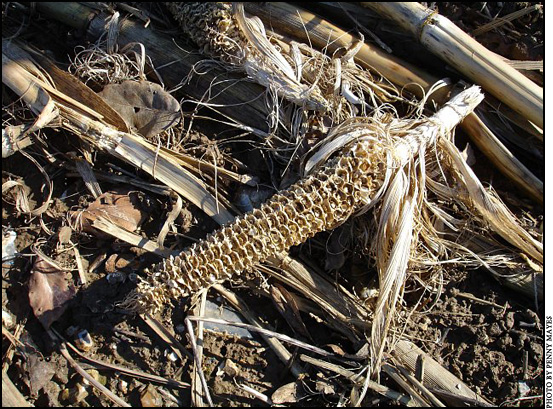
Increasing Corn Stover Digestibility
New process can improve feeders' profits using stalks, leaves, cobs currently left on field.
New research has shown that a substantial portion of the grain in cattle feed can be effectively replaced with corn stover — the plant's stalks, cobs and leaves — when these harvest residues are treated with a common food ingredient known as hydrated lime, or pickling lime.
The alternative feeding strategy, which could improve feeders' financial returns by lowering input costs without affecting the animals' physical development, has been validated through recent studies conducted at Iowa State University (ISU) and the University of Nebraska. In mid-February, Mike Baroni, vice president of economic policy for Archer Daniels Midland Co. (ADM) and Mike Cecava, ADM's director of feed technology, shared highlights of the research at a meeting of Illinois cattle feeders in Sycamore, Ill.
"With the world's food and energy needs growing, the implications of these findings could be quite significant," Baroni said. "Global agriculture needs to produce more using less water, fertilizer and other inputs, and without bringing vast amounts of new land into production. Using crop residues and coproducts, rather than higher-value grains, to help feed animals could enable the world to make more of the global harvest and help agriculture expand to meet all needs."
In cattle-feeding trials, adding hydrated lime to corn stover rendered the plant material sufficiently digestible to constitute up to 25% of cattle rations after the treated stover was combined with wet distillers' grains and solubles. WDGS, a protein-rich feed ingredient, is a coproduct of corn ethanol production. ADM is a leading supplier of distillers' grains to the livestock industry.
Hydrated lime, or calcium hydroxide, is used in a variety of food applications, from pickling and preserving fruits and vegetables to adding calcium to fruit juices and baby formulas. It is formed by mixing water with calcium oxide derived from limestone.
"These trials demonstrate that cattle feeders can implement alternative feed strategies today to improve their returns," added Cecava. "ADM's goal is to begin working with industry partners and university extension programs to help speed adoption by interested cattle feeders."
The treatment process involves combining ground or chopped stover with the hydrated lime solution, then storing the treated stover in an oxygen-free container — typically a plastic "ag bag" or a bunker — for at least a week. A 1,200-pound (lb.) stover bale can be treated with approximately 50 lb. of calcium hydroxide. The solution loosens the chemical bonds between the stover's less-digestible lignins and its more digestible components. The relaxing of these bonds enables natural enzymes in the cattle's front stomach to effectively digest the stover. The same treatment process can make wheat straw digestible to ruminants, as well.
Over the course of a six-month ISU trial involving 210 steers, the treatment enabled scientists to cut the percentage of grain in animals' rations by half — from 70% to 35% — without affecting the animals' growth or development. Stover, WDGS and supplements made up the remaining 20%, 40% and 5% of the ration's dry weight, respectively. Use of the treated-stover rations resulted in a profit per steer of up to $119.
A similarly structured, 140-day University of Nebraska study involving 330 steers showed equal success. Both the Nebraska and Iowa State studies were funded by ADM. Similar trials supported by ADM are under way at other institutions, including the University of Wisconsin, the University of Illinois and Purdue University.
Baroni noted that ADM, Deere & Co. and Monsanto were continuing to collaborate on economically and environmentally responsible methods for collecting, transporting and processing stover on an industrial scale. "In the meantime," he said, "the on-farm method offers a way for ranchers and feedlot operators to begin making more of this crop residue today.
 "It's conceivable that these findings could ultimately stimulate rural economic development as well," Baroni continued. "By creating a new market for stover, growers could begin to profit from selling plant material that traditionally has been of little value to them. And, other entrepreneurs could turn the stover trade into a burgeoning industry of its own."
"It's conceivable that these findings could ultimately stimulate rural economic development as well," Baroni continued. "By creating a new market for stover, growers could begin to profit from selling plant material that traditionally has been of little value to them. And, other entrepreneurs could turn the stover trade into a burgeoning industry of its own."
Cattle feeders interested in participating in further feeding trials with stover should contact Cecava.
Editor's Note: The article above was provided as a news release by ADM.




